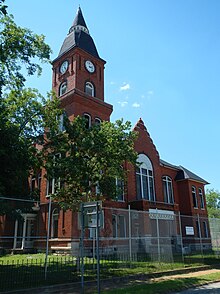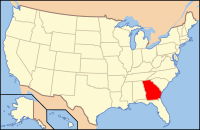Randolph County, Georgia
| Randolph County, Georgia | |
|---|---|

The Randolph County Courthouse in Cuthbert was placed on the Georgia Trust for Historic Preservation's 2012 list of "Places in Peril" due to extensive termite damage and general disrepair.
|
|
 Location in the U.S. state of Georgia |
|
 Georgia's location in the U.S. |
|
| Founded | December 20, 1828 |
| Named for | John Randolph of Roanoke |
| Seat | Cuthbert |
| Largest city | Cuthbert |
| Area | |
| • Total | 431 sq mi (1,116 km2) |
| • Land | 428 sq mi (1,109 km2) |
| • Water | 2.6 sq mi (7 km2), 0.6% |
| Population | |
| • (2010) | 7,719 |
| • Density | 18/sq mi (7/km²) |
| Congressional district | 2nd |
| Time zone | Eastern: UTC-5/-4 |
| Website | www |
Randolph County is a county located in the southwestern portion of the US state of Georgia and is considered part of the Black Belt, historically an area of plantations. As of the 2010 census, the population was 7,719., less than half its peak population in 1910, when there were numerous agricultural workers. The county seat is Cuthbert.
Randolph County was created by European Americans on December 20, 1828, and named after the Virginia planter and politician, John Randolph.
He was honored originally as the namesake of present-day Jasper County but, because of his opposition to U.S. entry into the War of 1812, the Georgia General Assembly changed the county name in December 10, 1812. Eventually, John Randolph's reputation was restored. In 1828, the General Assembly organized the current Randolph County in the west of the state. Most of the historic tribe of Muscogee people (Creek) were forced from the area to Indian Territory during Indian Removal.
Lumpkin, Georgia was the original county seat. It was within the portion of Randolph County that was reassigned in 1830 to form Stewart County, and Lumpkin was designated as the latter's county seat.
This area is considered part of the Black Belt, upland areas across the Deep South that were developed in the 19th century as plantations after invention of the cotton gin made processing of short-staple cotton profitable. Enslaved African Americans made up the vast majority of workers on the plantations, with hundreds of thousands being transported through the domestic slave trade from the coast and Upper South. After the American Civil War, many freedmen and their descendants continued to work on plantations in the county and region, comprising the majority of county population until the 1930s.
...
Wikipedia
